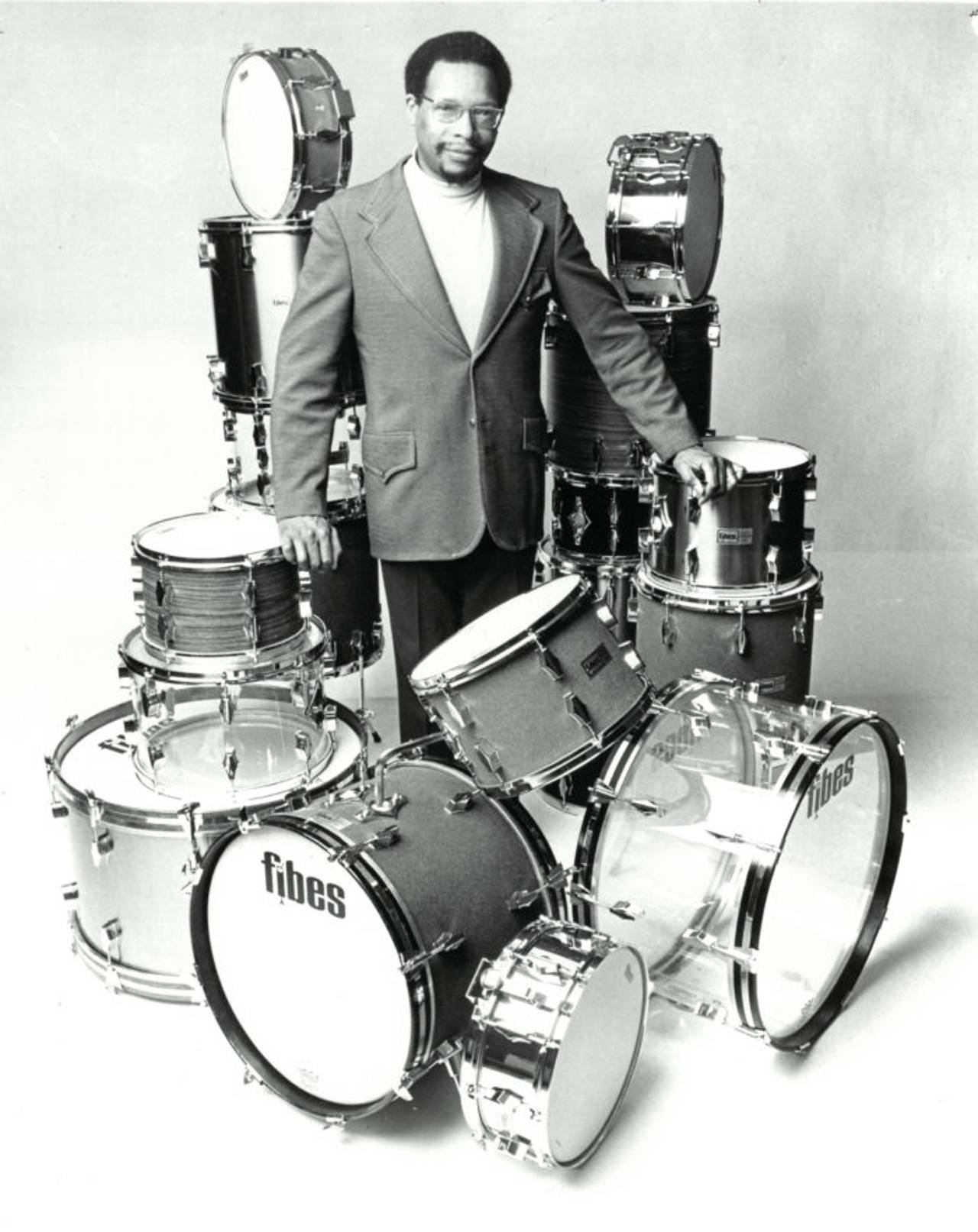Had Alan Dawson lived, 14 July 2024 would have been his 95th birthday. But for many in the drum-playing fraternity, he is still very much alive. The Boston-area native stands as one of the most dynamic drummers in the history of the instrument.
He began experiencing lower-back ailments, the bane of the drummer. By the mid-1950s he felt it was nigh time he shared more of his wisdom and expertise with young players – Tony Williams, Steve Smith, and Vinnie Colaiuta for example – he began teaching more than he’d anticipated but he certainly lost nothing of substance in the gigging department. Meanwhile, his tenure at the Berklee School of Music was the stuff of legend.
We asked resident drum authority T Bruce Wittet to write a tribute. Bruce responded enthusiastically but cautioned, “Alan Dawson is one of a precious few on my wish list I never crossed paths with in the 31-years I spent writing for Modern Drummer (NJ) magazine. I’ve rubbed shoulders with Alan’s peers and his students, though, and probably have a perspective worth sharing. Let me at it!”
T Bruce Wittet writes: Alan Dawson touched many, many drummers. He wasn’t one of those musicians who played, in his case, gigs every jazz drummer of his day coveted, then when the gig scene was quiet, supplemented his performance fees with income from a teaching practice. It’s good business, you know, as our parents were always saying, “have something to fall back on”. Good counsel, that. Your name might be accidentally erased from leaders’ phone books, or you might have gone out of fashion. That hurts. I did eight albums with a legendary Canadian songwriter. I thought we were in it for the long run until he stopped calling.
Alan Dawson gigged because he wasn’t afraid to play the way he heard it. He was a sensitive drummer who understood the many styles that fell under “jazz”. He gigged or recorded with George Shearing, Dave Brubeck, Booker Ervin (the setting wherein I discovered him), Dexter Gordon, Lionel Hampton (to paraphrase Alan’s depiction: a three year gig that felt like fifteen), Phil Woods, Sonny Stitt, Bill Evans, Terry Gibbs. What struck me, pardon the pun, is the aggression with which he played some of the dates. He played louder than most with Bill Evans. He fired off daring fills that would challenge most drummers to play them in time—and to understand them in concept. Drummerworld has very good audio and video evidence of the excitement he worked up on the bandstand.
Dawson’s ability to teach mastery did not fall on deaf ears. We’re talking the elder statesmen of jazz and fusion music, including Harvey Mason, Dave Weckl, Joe Morello, Vinnie Colaiuta, Terri Lyne Carrington, Joe Corsello, and Steve Smith. Then there was Tony Williams, another Boston-area resident like Alan Dawson. The story goes that Tony’s drumming was already well above-average when he showed the audacity to approach Miles Davis with a request to sit in. They had words and Miles told Tony to be off to study, some say by name, with Alan Dawson. Learn his rudiments inside out,which, of course, is exactly what Dawson taught.
Tony Williams started out as a drummer showing more promise that most. Dawson gave him structure, a firm foundation, while giving his ideas wings. The result is that when Tony did join up with Miles Davis at age-17, the music that flowed from the quintet was unprecedented. Tony, reflecting Dawson’s teaching, has left the world a sound, a modus involving hyper-control of the sticks and a de-emphasis on bounce. It started with recordings such as the following, one of my favorites. Hats off to YouTube for allowing us to audition records such as one of my favourites, “Miles Smiles”, which I see as chamber music for the jazz world.
At some point in his career, Alan Dawson was troubled by lower-back issues—the drummer’s bane. Thus, he began leaning on teaching instead of schlepping. At Berklee College of Music, where Dawson taught for decades, he refined his deep understanding of the drums and how best to teach them. He could ‘read’ students and observe them, instantly diagnosing and prescribing remedies for technical problems. He alerted students to the looseness that allowed music to breathe, the tightness that made fills pop like fireworks, and he taught various ways of elongated phrasing to eliminate predictable fills every eight bars.
The Cursed Ritual
This is an Alan Dawson original. I’ve been playing drums for fifty-some years and I still can’t play “the ritual”, a series of rudiments that flow like silver over an ostinato bass drum playing a sort of samba that provided an even four-feel as a foundation. Now if you’re a hardy soul, nimble and patient, you might, after six months or so, complete part-one of the ritual. Trust me, it is the longest four minutes known to humans. It’s a spitefully long, horridly juxtaposed parade of rudiments that must be played as written. It’s a work of genius when you take a closer look at what Dawson has chosen to do with placement. And every drummer who can do it tries to look relaxed—as relaxed as someone singing in the church choir, whose lower digestive system complaint has, as it were, reached a head. I wouldn’t have lasted in Dawson’s class. I’d be done after six rudiments and plenty proud, too. But over twenty-six of them. In a row? Without stopping?
Although Dawson was stricken with leukemia and died in 1996, he left witnesses to explain and to carry his teaching. Perhaps more important, especially for those relying only on texts about “the jazz life” and on anecdotal evidence from survivors, was the library of music Alan Dawson left us and now, of course, the steady stream of material leaking out from nooks and crannies around the globe.
Knowing Songs
I never met Alan but I knew his contemporary Jim Blakely, a guru drum instructor who’d come from Edinburgh to play jazz in New York before settling in Toronto, Canada and teaching. In fact, he rented the house of a former student, Terry Clarke, for decades. He spoke of the importance of knowing songs, not in the manner of rock players, who say “I play for the song, man”. Instead we’re talking about song form, as in a blues might consist of twelve or sixteen bars, intervals of one, four, five and so on. To be able to identify forms is a valuable tool that eases the burden of sight reading. Dawson like Blakely had ways of dropping the needle on vinyl and having students identify the location.
It’s refreshing to see that new students are onto the teachings of Alan Dawson. One such is a writer who has just had his first book of snare drum exercises published in New York. Daniel Bedard is one of those who are consumed by music morning, noon, and night-time. “His ideas seem so fresh. He didn’t get the recognition I thought he deserved. For those of us who didn’t get to see him live, seeing him on Youtube is a total delight. Working through his ideas has been paying off big time for me. His ritual is such a genius way of linking all those rudiments and so musical. Alan Dawson was one of a kind.
I Owe this Man but Never Studied with Him
When I first heard Dawson with Booker Ervin, I got a glimpse of possibilities I hadn’t imagined. For example, there was this fill he’d tend to do wherein he’d play doubles on all drums including the bass drum and change the order from say snare, toms, to bass drum to tom, bass drum, snare drum. It was, for me, a breath of fresh air. I realize that after this length of time using that figure, I may owe his estate royalties.
Similarly, Dawson’s choice of drums reflected this fresh attitude to fills and ensemble playing. He used a 20” bass drum instead of the usual 18” diameter for the extra body it afforded. Similarly, he had the Fibes company make him 15” diameter floor toms instead of the standard 14” drums that populated jazz setups. Instead of standard Zildjian cymbals made in Boston/Quincy/Norwell, Alan preferred the relatively new Mini-Cup rides and crashes. The bell on a cymbal promotes crash qualities. By decreasing the bell size, you experience less wash. Here we see the triumph of articulation even in cymbal choice.
There is so much more to Alan Dawson, such as his encouragement to students to execute figures with brushes, thereby improving their performance on sticks! It’s not just that he was a great player and teacher; Alan Dawson had figured out how the drummer goes about business — the business of how to obtain sounds while keeping rhythms hopping at various dynamic levels. We salute him.
ALAN DAWSON 14 July 1929 – 23 February 1996


